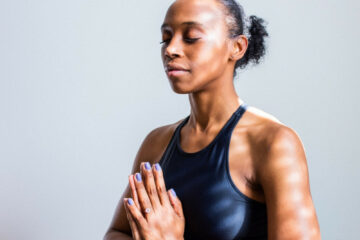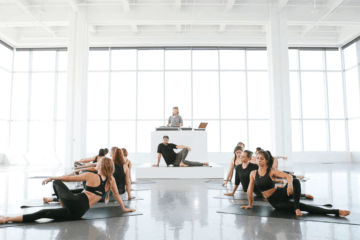Yoga Tips for Beginners at Home: 9 Things You Need to Know
So you’ve decided to try yoga. New to it? No problem. Here are tips for yoga beginners at home that you should know before you hop on to your mat. And no, your mat need not branded! We’ll get to that, so read on.
Fair energy exchange applies in links inside this post. That means, as I hunt for the best products, Amazon pays me a small $ if you take my recommendation. For more details, my full affiliate disclosure can be found at the blog footer. /highfive!
1. Always set an intention.

Most yoga sessions in studios (1 hr, 30 mins) involve intention-setting or a brief meditation in the beginning. Most recorded classes are just 30 minutes, so you’ll get down to business right away. Whether or not the instructor you booked does this, it would be nice to have one ready–it’s always for you.
The intention is one of the most important parts of the practice that we tend to overlook.
When you are a beginner, you are planting seeds. You are setting yourself up for success. Intention-setting acts as a light on your path, if not your cheerleader energetically. It will be your anchor when the going gets tough (in poses, or in life in general).
It could be this way: May I let go of my need to compare myself with others, or I dedicate this practice to my beloved mom.
2. Use what you have at home.
This article is about yoga tips for beginners at home, so let me put in my practical 2 cents worth: you don’t have to buy something fancy. Just buy the cheapest one you can find for a mat. Nope, it doesn’t have to be a Liforme, Alo, or Manduka. Even generic ones can do the trick. Extra sweaty? Grab your bath towel and put it on top. Microfiber towels do not give you that grip (even if it’s an Amazon’s Choice), and they wouldn’t tell you that. Bath towels are better.
“What should I wear?” you say. You can actually wear anything, for as long as you are comfortable with it. I find yoga shorts more comfortable. But I tend to skip it because a pair of leggings can do the trick for some challenging poses like crow or eagle pose.
Use a pile of books if you don’t like yoga blocks (I prefer cork ones because of durability), and a belt as your yoga strap. I strongly recommend that you wouldn’t spend a dime when you’re starting. Otherwise, you will focus on your growing your fancy accessories instead of finding the deeper meaning of the practice. This brings me to Yoga Tip #3.
3. Smile and deep breaths are your greatest tools.
Just showing up is what would propel your practice. While your accessories can perhaps make you feel lovely, it is self-trust that you would need to access at the core of the practice. And your fancy tools will not help you with that. You are exactly where you need to be, and you have all the tools you need with you right now. When you struggle in the middle, smile it out and focus on your breathing. I swear, it will instantly make it easier.
4. Know that not all yogis are flexible.
I repeat:
You are exactly where you need to be.

Also, just because you are practicing it for years, it doesn’t mean that you will be flexible. No, I don’t mean that you WOULDN’T BE flexible. You will, of course, in time, especially if this becomes your focus.
Yoga has a myriad of poses and goals to work on, so choose where you would want to focus. In yoga, there is no one and only end goal. You only get deeper as you practice regularly. And it’s not like going to the gym–what you have started will not be wasted once you stop. I bet that you wouldn’t even stop.
We all started as beginners. Regardless of your reason to start, it is just the tip of the iceberg.
Yoga is far much deeper than what you see on others or read in books–and your unique discovery of this depth is what would make you thank yourself in the future.
5. Your yoga teacher is not any better than you.
Your yoga teacher is your instant mentor. Try your best to not be intimidated by them. They have you first in mind not because you paid, but because all yoga teachers are trained to assist another soul.
The most confident (if not the best) yoga teachers are those who make it less about them.

Just because your friend can do a headstand, it doesn’t mean that he/she is better than you. Moreover, just because your instructor “knows it all,” it doesn’t mean that they are the flexible and fit gods of the universe. Our bodies are made differently, so you will learn by experience that comparison will bring you nowhere.
6. There is no straight-cut way to do a pose.
Yoga is not about perfection, but progress.
“Practice makes progress” is my motto in life, and I learned that in yoga.
You don’t have to worry about getting straight to the pose on the first try. In fact, you don’t even have to think about completely getting it the way your instructor or classmates do it. You may feel disillusioned because a pose you’ve seen online is utterly hard to do and it makes you want to quit, but know that any pose that seems so hard today would definitely be easy tomorrow. That’s a yoga promise.
You may have seen yogis who seem to have it all together. While it’s a fact that you can get it all together when you do yoga, you will figure out your own way of doing things as you start your yoga practice. There is no one way of doing things in yoga. And you will learn about various transitions along the way. See what works for you.
7. Be kind to yourself.
You can do a headstand today and might not be able to do it tomorrow.
Each practice is unique. It depends on what’s going on around you, what you have eaten prior, or simply your mood. Yoga is one way to slough off unwanted energies, and you can do that even if it’s just a very quick practice. You don’t have to do the pose as the instructor shows it, just feel into your body with where you are at today. You wouldn’t even want to be injured, so listen to your instructor.
8. A 20-minute practice is no less than a 1 hr one.
You will reap the same benefits even if you practice for a shorter time. Your presence is the most essential tool you can bring to a yoga class. Just showing up is what it takes. A 20-minute practice is enough to connect with your breath and get into the flow. Certainly, your body and soul will thank you for it.
Practicing yoga is saying yes to yourself.

9. Practice for 21 days straight.
Practice, practice, practice. It takes just 21 days to build a habit. And yes, it doesn’t have to be a full hour. By the end of the 21 days, you will definitely notice wonderful changes internally and externally in yourself.
While diligence may bring you “results” faster, yoga is not your academic class in which the instructor will mark you as their favorite, or that you are at the top if you get the poses right away.
Your first class is just the beginning of a deeper practice. Practicing every day will make you feel better and radiate faster. You will learn more about yourself, your body, and you will unlock your potential. Poses you do today as you begin will get easier by the day. Yogis affirm.
Conclusion
Yoga is not fancy. The true meaning of the practice has nothing to do with how it looks. It’s how you feel. A home practice not any less than studio practice. While it’s much better that your instructor could see you so they could do the necessary corrections instantly, it wouldn’t hurt if you would want to just subscribe to videos. Remember that practice makes progress. And as my Bikram teacher on my first try said: It’s just the beginning.



0 Comments